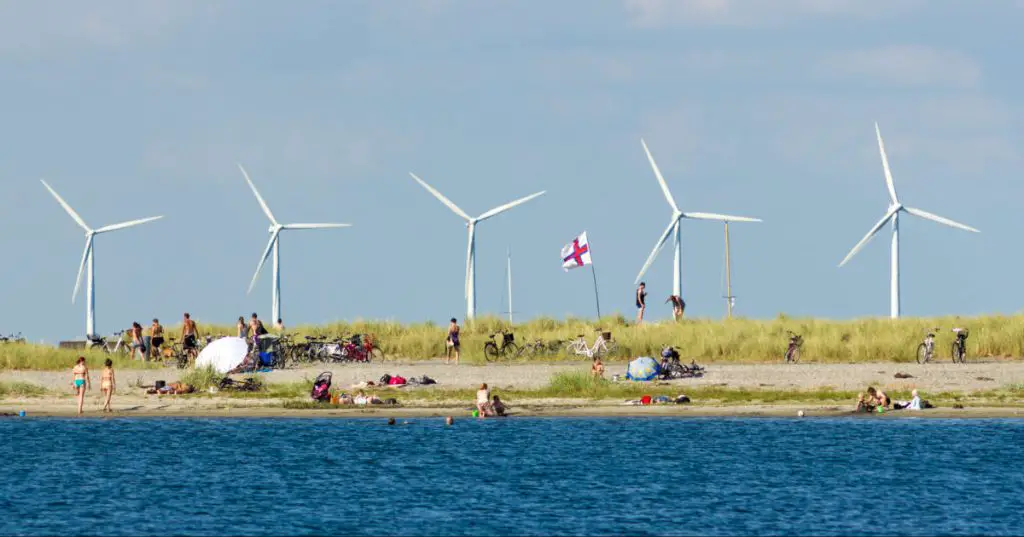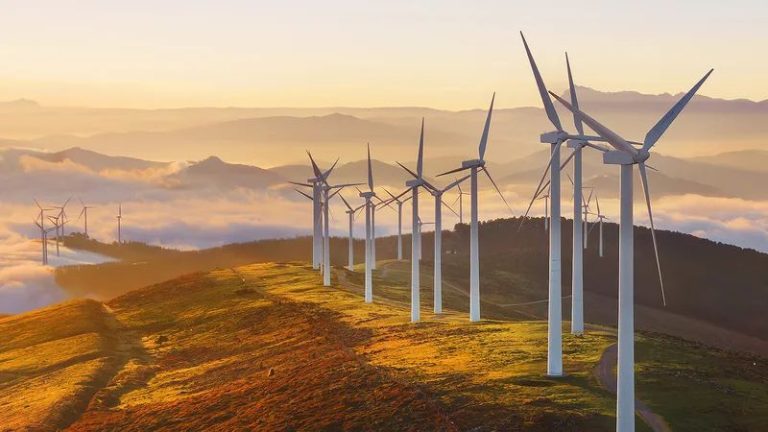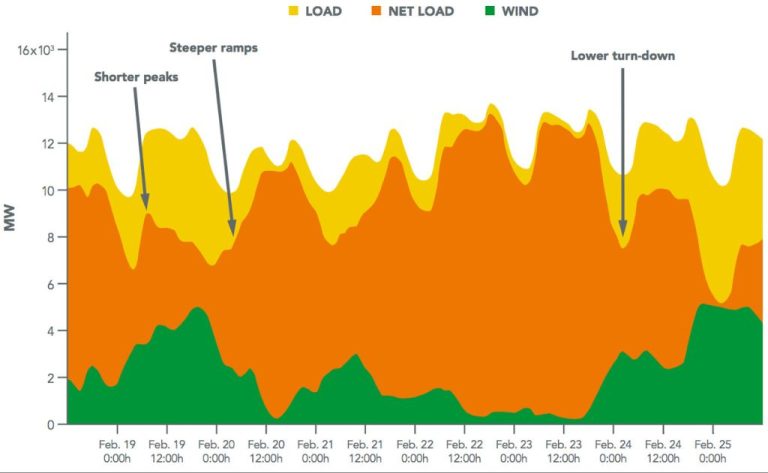Are There Windmills In Denmark?

Denmark is a global leader in wind power generation and has a long history of harnessing the wind for energy.
With roughly 6,000 onshore and offshore wind turbines producing over 40% of its electricity usage, Denmark is among the top countries in the world utilizing wind as a renewable energy source.
The iconic white windmills dotting the pastoral countryside are a symbol of Denmark’s commitment to environmentally-friendly energy production and its efforts to reduce reliance on fossil fuels.
From the earliest windmills pumping water and grinding grain to today’s massive offshore wind farms and wind turbine manufacturing industry, harnessing the wind has been an integral part of Denmark’s identity.
This article will explore the origins, rise, current status, and future of wind power in Denmark – a country where the windmill holds an enduring place in the national imagination.
History of Windmills in Denmark
Denmark has a long history of harnessing wind power. The first known windmills were built in Denmark as early as the late 12th century. These early mills were vertical axis mills used for grinding grain or draining land. In 1891, Poul la Cour built the first Danish electricity generating wind turbine, which sparked further development in wind technology and applications in Denmark (source).
In 1903, the Danish Wind Electricity Society was formed, establishing Denmark as a pioneer in wind generated electricity. The society worked to expand and improve wind turbines, leading to increasingly larger and more efficient designs (source). Denmark was an early adopter of wind technology for electricity, pumping water, and grinding grain.
Modern Wind Power Usage
Today, Denmark has one of the highest wind power capacities in the world. According to the IEA Wind TCP, Denmark’s total wind power capacity was 6,995 MW in 2022 (IEA Wind – Denmark). Wind power accounts for approximately 50% of Denmark’s electrical consumption. In 2021 alone, wind power capacity in Denmark increased by 754 MW (Power Technology). The country generates over 40% of its electricity from wind, one of the highest in Europe. With ample coastline access, Denmark has invested heavily in offshore wind farms, with 1.7 GW of offshore wind capacity in 2021. The Danish government has set a target of installing at least 2 GW of new offshore wind power by 2030. The country also aims to reduce greenhouse gas emissions by 70% by 2030, with wind power playing a major role in this energy transition.
Wind Turbine Manufacturing
Denmark has become a leading manufacturer of wind turbines, with Danish companies accounting for a large share of the global wind turbine market. Major Danish wind turbine manufacturers include Vestas, Siemens Gamesa Renewable Energy, Nordex Acciona, and LM Wind Power.
Vestas is the largest wind turbine manufacturer in Denmark and one of the largest in the world. The company has produced over 100,000 wind turbines across 80 countries. Vestas operates multiple manufacturing facilities in Denmark and exports turbines globally. The company produces onshore and offshore wind turbines with power ratings from 2 MW to 10 MW.
Siemens Gamesa Renewable Energy is another major global wind turbine OEM with a strong presence in Denmark. The company manufactures offshore wind turbines at a facility in Aalborg. Other Danish manufacturing facilities focus on developing new technologies and solutions for the wind power industry.
LM Wind Power, headquartered in Denmark, is one of the leading suppliers of wind turbine blades, operating factories in several countries. The company produces over 200,000 wind turbine blades per year. Blades manufactured by LM Wind Power equip one out of every three wind turbines around the world.
Overall, Danish wind turbine manufacturers play a vital role in the global wind energy industry, leveraging decades of experience and technical expertise within Denmark’s robust domestic wind power sector.
Offshore Wind Farms
Denmark has been a pioneer in developing offshore wind farms due to its extensive coastline and strong wind resources. The country built the world’s first offshore wind farm called Vindeby in 1991 near the island of Lolland. It had 11 turbines with a capacity of 4.95 MW [1]. Today, Denmark has 15 operational offshore wind farms producing over 2,300 MW of power [2].
The strategic location of wind farms along Denmark’s 7,300 km long coastline allows them to maximize energy generation. Offshore winds tend to blow stronger and more uniformly compared to onshore locations. The open seas provide minimal obstacles, enabling large wind turbines to operate optimally. This results in higher capacity factors and greater power output.
Some of the largest offshore wind farms in Denmark are Anholt (400 MW), Horns Rev 2 (209 MW) and Horns Rev 1 (160 MW). These mega wind farms generate enough clean electricity to power hundreds of thousands of households. Denmark aims to continue expanding offshore wind capacity to meet its renewable energy targets and position itself as a green energy leader.
Wind Power Percentage
Denmark gets a very high percentage of its electricity from wind power. According to the Danish Wind Industry Association, wind power accounted for approximately 47% of Denmark’s electricity consumption in 2019.1 On windy days, wind turbines can sometimes generate up to 140% of Denmark’s electricity needs.2 The Danish government has set a goal for wind power to provide at least 50% of the country’s electricity by 2020 and to be entirely fossil fuel-free by 2050.3 With its massive wind power generation capacity, Denmark is able to export excess electricity to its neighboring countries.
Wind Power Export
Denmark has become a major exporter of wind power to its neighboring countries. According to Energy Export, Denmark exported over 15 terawatt hours of wind power in 2021, making it one of the largest exporters of renewable energy in Europe.
The development of large offshore wind farms like Horns Rev has enabled Denmark to produce more wind power than it consumes domestically. The excess wind energy is exported to Germany, Norway, Sweden and other countries through transmission interconnectors.
An article on the State of Green website states that Danish exports of wind energy equipment and services totaled nearly 9 billion euros in 2019. The export of wind technology and expertise continues to be an important part of Denmark’s economy.
As Denmark builds more offshore capacity, its potential to export clean energy is expected to increase. Interconnectors like the planned Energy Island in the North Sea will help transmit power to neighboring countries working to decarbonize their energy systems.
Future Expansion Plans
Denmark has set ambitious goals to continue expanding its wind power capacity in the coming years. According to the Danish government, the country intends to quadruple its onshore wind and solar generation ahead of 2030. This would involve increasing onshore wind capacity from around 6 GW today to 24 GW by 2030. The government has described this as a “big step forward” towards its renewable energy targets.
Denmark is also looking at ways to overcome restrictions and expand onshore wind further, with plans to build turbines taller than 150 meters. According to Wind Power Monthly, Denmark aims to lift limitations on onshore wind farm sizes and turbine heights that have slowed growth in recent years. This could pave the way for more expansion through the 2020s.
Overall, the goals highlight Denmark’s commitment to keep rapidly growing its wind power capacity through the next decade and beyond.
Wind Power Challenges
Denmark faces some challenges as wind power expands in the country. One is ensuring grid stability as the share of wind power increases. Wind power is intermittent, so relying heavily on it makes maintaining a stable electric grid more difficult (Wang, 2017). Denmark will need to continue developing ways to balance wind power with other energy sources.
Another challenge is that many of Denmark’s wind turbines are aging. The first wind turbines installed in the 1970s and 1980s are approaching the end of their operational lifetime. Replacing and upgrading older turbines will require substantial investment in the coming years (Wang, 2017). However Denmark handles this, it demonstrates the long-term costs and planning involved in scaling up renewable energy.
Conclusion
To summarize, wind power and windmills are an integral part of the Danish energy mix, representing over 50% of the country’s electricity production. Energy independence has been a priority for Denmark since the 1970s oil crisis, leading to pioneering efforts in wind turbine technology and implementation. Today, Denmark is a leading exporter of wind turbines and expertise. As the country aims for 100% renewable energy by 2050, wind power will continue playing a major role. The windy conditions due to Denmark’s flat terrain and coastal location provide ideal generation capacity. While scaling up has led to some challenges with grid stability and local opposition, the Danish experience demonstrates the viability of high wind power integration. Overall, windmills are an icon of innovation and sustainability in Denmark.



